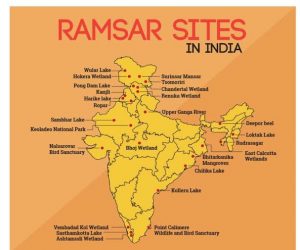Ramsar Sites :Increased

The Ministry of Environment, Forest and Climate Change announced that on the eve of World Wetlands Day, 2024, India has increased its tally of Ramsar sites to 80 from the existing 75 by designating five more wetlands as Ramsar sites.
- Three of these sites, Ankasamudra Bird Conservation Reserve, Aghanashini Estuary and Magadi Kere Conservation Reserve are located in Karnataka whereas two, Karaivetti Bird Sanctuary and Longwood Shola Reserve Forest are in Tamilnadu.
- Tamil Nadu continues to have the maximum number of Ramsar Sites (16 sites) followed by Uttar Pradesh (10 sites).
- Ramsar Convention is an intergovernmental treaty, adopted on 2nd February 1971, in the Iranian city of Ramsar, on the southern shore of the Caspian Sea.
- In India, it came into force on 1st February 1982, under which wetlands of international importance are declared as Ramsar sites.
Ankasamudra Bird Conservation Reserve (Karnataka):
- It is a human-made village irrigation tank built centuries back and is spread over an area of 244.04 acres adjoining the Ankasamudra village.
Aghanashini Estuary (Karnataka):
- It is spread over an area of 4801 ha, and is formed at the confluence of the Aghanashini River with the Arabian Sea.
- The brackish water of the estuary provides diverse ecosystem services including flood and erosion risk mitigation, biodiversity conservation and livelihood support.
- The wetland also provides livelihoods by supporting fishing, agriculture, collection of edible bivalves and crabs, shrimp aquaculture, traditional fish farming in the estuarine rice fields (locally known as Gazni rice fields) and salt production.
Magadi Kere Conservation Reserve (Karnataka):
- It is a human-made wetland with an area of nearly 50 hectares which was constructed to store rainwater for irrigation purposes.
- The wetland harbors two vulnerable species, namely Common pochard (Aythya ferina) and River tern (Sterna aurantia) and four near-threatened species namely Oriental Darter (Anhinga melanogaster), Black-headed Ibis (Threskiornis melanocephalus), Woolly- necked Stork (Ciconia episcopus) and Painted Stork (Mycteria leucocephala).
- It is also one of the largest wintering grounds for the Bar-headed goose (Anser indicus) in Southern India. It has been declared globally as an Important Bird and Biodiversity Area (IBA).
Karaivetti Bird Sanctuary (Tamil Nadu):
- Water from the wetland is utilized by the villagers for cultivating agricultural crops such as paddy, sugar cane, cotton, corn, and split red gram.
- About 198 species of birds have been recorded here; some of the important visitors being the Bar headed Goose, Pin-tailed duck, Garganey, Northern Shoveler, Common Pochard, Eurasian Wigeon, Common teal and Cotton teal.
Longwood Shola Reserve Forest (Tamil Nadu):
- It derives its name from the Tamil word, “Solai”, which means a ‘tropical rainforest’.
- The ‘Sholas’ are found in the upper reaches of the Nilgiris, Anamalais, Palni hills, Kalakadu, Mundanthurai and Kanyakumari in Tamil Nadu.
- These forested wetlands serve as habitats for the globally endangered Black-chinned Nilgiri Laughing thrush (Strophocincla cachinnans), Nilgiri Blue Robin (Myiomela major), and vulnerable Nilgiri Wood-pigeon (Columba elphinstonii).




